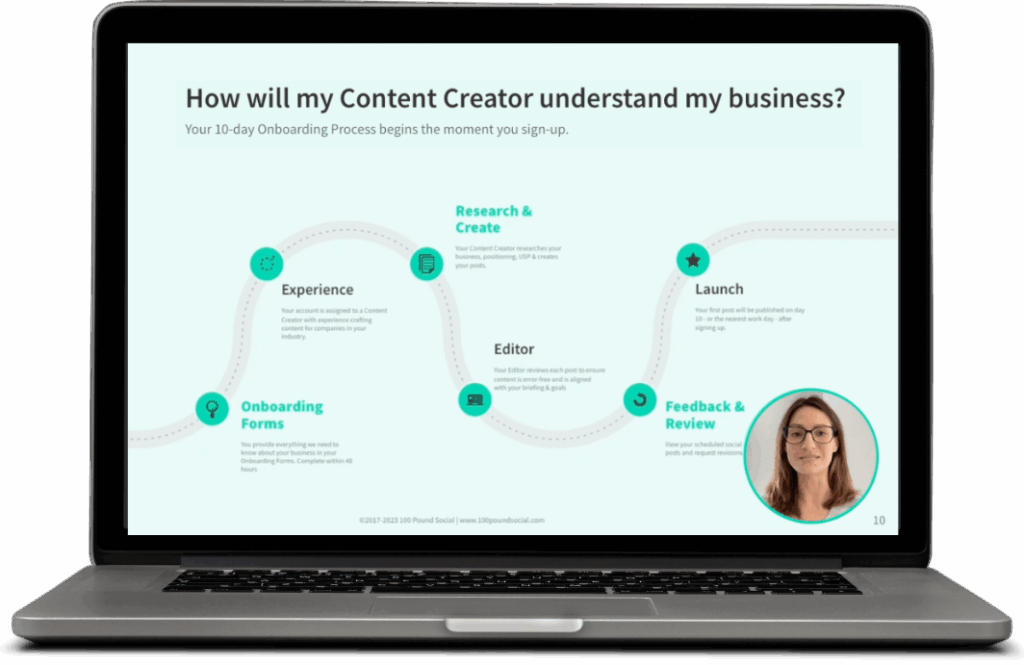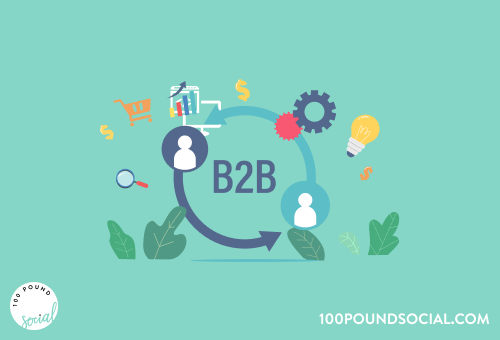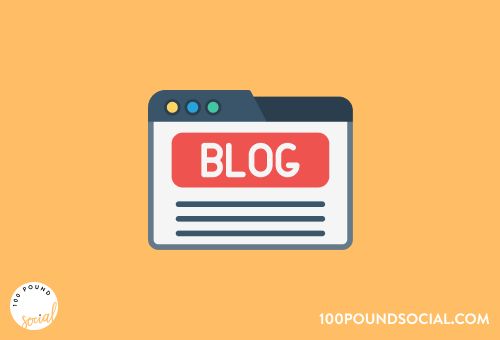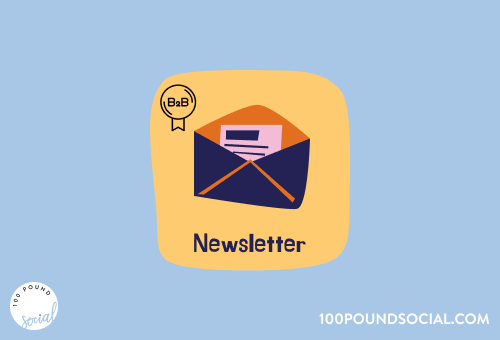Email newsletters aren’t going anywhere.
Despite the constant chatter about new marketing channels and social media algorithms, email continues to deliver an impressive return on investment.
Small businesses (in particular) find that consistent, value-driven newsletters help them stay connected with their audience in a way that feels personal and direct.
The challenge?
Keeping your newsletter content ideas fresh and engaging when you’re already juggling a dozen other responsibilities. Many business owners start strong with their newsletters but quickly run out of email newsletter ideas or fall into repetitive patterns that make subscribers hit the unsubscribe button.
You send the same “company updates” month after month, or worse, your newsletter becomes a thinly disguised sales pitch that readers learn to ignore.
If you’re nodding along, you’re in the right place. This article shares 15 practical, low-effort email newsletter ideas that will help you create engaging email content your audience actually wants to read, without spending hours brainstorming or writing.
Each idea comes with specific email newsletter examples and implementation tips you can use immediately.
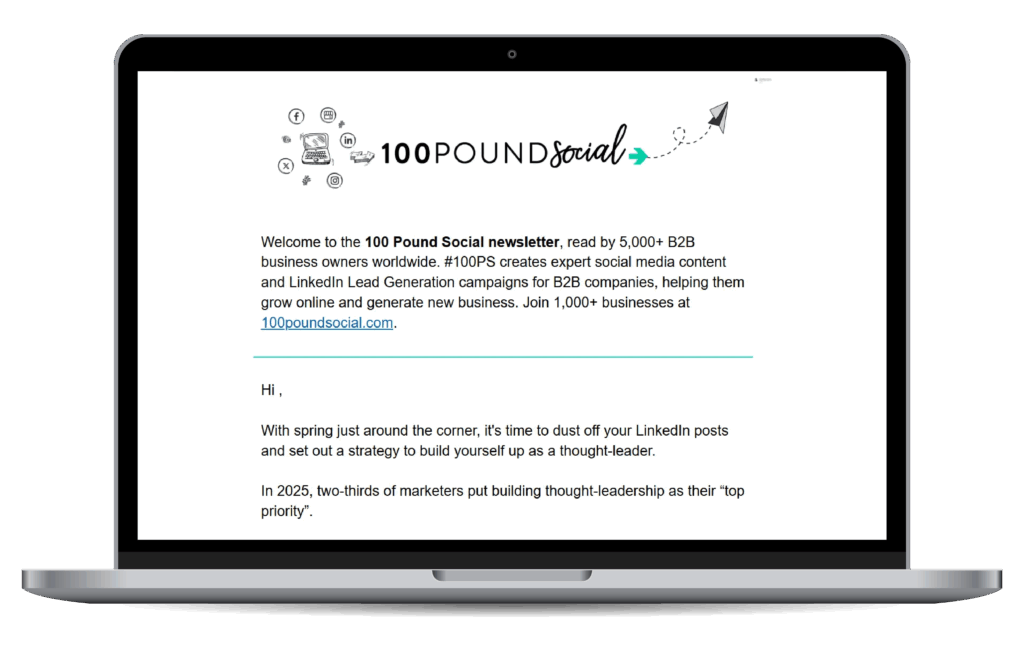
Why Email Still Works in 2025
While everyone’s chasing the latest social media trend, email remains remarkably effective in 2025.
The numbers speak for themselves: email marketing generates more leads than social media, and email newsletters have an average open rate of 35.63% across industries.
But here’s what really matters—some businesses are achieving far better results when they get their approach right.
The key difference between newsletters that work and those that don’t?
The human touch.
People can spot automated, generic content from a mile away. They want to hear from real people about real experiences, insights, and stories. That’s exactly what keeps them opening your emails week after week, rather than relegating them to the spam folder.
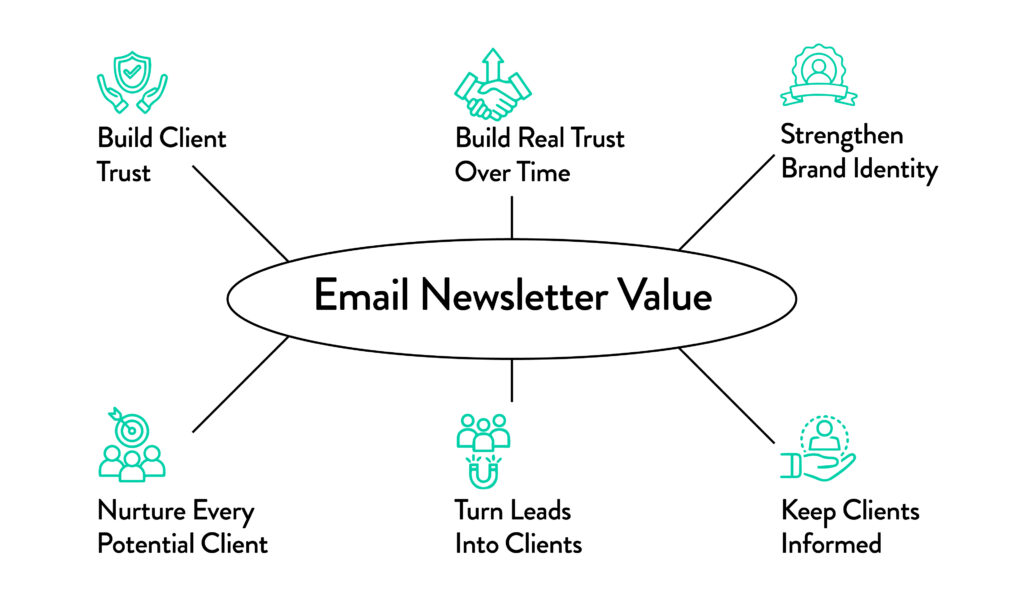
15 Engaging Email Content Newsletter Ideas for 2025
With proven success stories like Orange Malone’s 50% open rate, the future looks bright.
Email marketing strategies continue to prove effective, and industry benchmarks show strong engagement rates.
As such, the following ideas will help you create content that stands out in crowded inboxes.
1. Client Spotlight: Real Email Newsletter Examples That Work
Share a success story or testimonial from someone you’ve worked with recently, but go beyond a simple quote. People love hearing about real results, and it subtly demonstrates your expertise without feeling pushy. The key is to tell a complete story that your audience can relate to and learn from.
Take Orange Malone, for example. This investment recruitment specialist was struggling with generic, dull content from their previous marketing company.
After switching to a more personalised, industry-focused approach, they’re now seeing a 50% newsletter open rate—significantly higher than the industry average.
Sophie Peterson, the company’s owner, credits this success to content that feels relevant and genuinely helpful rather than promotional: “It gets me in my mailing list subscribers’ inboxes so I’m really happy.”
To make this work, start with the challenge your client was facing—something your other subscribers might recognise in their own businesses. Then walk through the solution you provided and the specific results they achieved.
For example, you might feature how a client increased their sales by 30% after implementing your recommendations, but include details about what they were struggling with initially, what changes you suggested, and how long it took to see results.
Get Expert SEO Blog & Newsletter Content From £120/Month →
2. Quick Tips: Easy-to-Implement Email Content Ideas
Offer a single, actionable tip related to your service that readers can implement immediately.
The magic is in the specificity—avoid broad advice like “improve your client service” and instead share something concrete like “respond to client complaints within 2 hours, even if it’s just to acknowledge you’ve received their message and will follow up with a full response by [specific time].”
Keep it simple and focused on something they can try within the next hour or day. This builds trust and positions you as someone who genuinely wants to help, not just sell. Include a brief explanation of why this tip works and what results they might expect to see.
3. Behind-the-Scenes: Engaging Email Content That Builds Connection
Give your audience a peek into how you work, introduce team members, or share the tools you use daily. This humanises your business and helps people feel more connected to you as a real person rather than just a business name in their inbox.
You might show your workspace and explain how you’ve organised it for productivity, or walk through your process for handling a typical project from start to finish. Introduce a new team member with their background, what they’re passionate about, and maybe a fun fact that makes them memorable.
Share the software tools, apps, or even physical products that make your work easier and explain why you chose them.
4. Trending Topic Breakdown: Newsletter Content Ideas That Keep You Current
Pick a relevant industry news story and share your perspective on what it means for your audience. This positions you as someone who stays current and can help others make sense of complex information. The key is to move beyond simply reporting what happened and focus on practical implications.
Choose news that genuinely affects your audience’s work or decisions. Then break it down into plain language, explain why it matters, and most importantly, tell them what they should do about it.
For example, if there’s a new regulation in your industry, don’t just explain what it says—tell your readers what steps they need to take to comply and when they need to take them.
5. Free Download or Resource: Email Newsletter Ideas That Add Value
Offer a helpful tool, template, or checklist that solves a common problem your audience faces. This adds immediate value and gives people a reason to stay subscribed, but it needs to be genuinely useful, not just a thinly veiled sales pitch.
Think about the tasks your clients or prospects do repeatedly that could be made easier with a simple resource.
This might be a checklist for preparing for a consultation, a template for tracking important metrics, or a worksheet for planning their next project. The best resources save people time or help them avoid common mistakes.
6. Expert Q&A: Fresh Email Newsletter Examples From Industry Leaders
Interview someone your audience trusts or admires, or compile and answer common questions you receive from clients. This provides fresh perspectives and shows you’re connected to other experts in your field, while also giving you content that feels authoritative and helpful.
For interviews, choose people who can offer insights your audience wouldn’t get elsewhere.
This could be an industry leader, a satisfied client who’s achieved impressive results, or even a team member with specialised knowledge. Prepare thoughtful questions that go beyond surface-level topics and focus on practical advice or interesting perspectives.
7. Stats Roundup: Data-Driven Newsletter Content Ideas
Share interesting industry statistics and explain what they mean in practical terms. Numbers catch attention, but your interpretation makes them valuable.
Focus on stats that surprise, inform, or challenge common assumptions in your field.
Don’t just list numbers—tell the story behind them. If you’re sharing a statistic about industry growth, explain what’s driving that growth and what it means for your audience’s businesses. If it’s a survey result about client behaviour, discuss how your readers might adjust their approach based on this information.
Choose statistics that are recent, relevant, and from credible sources. Three to five interesting stats with good analysis work better than a long list of numbers. Always include a link to where you found the information so readers can learn more if they’re interested.
8. Upcoming Events or Webinars: Engaging Email Content for Community Building
Share relevant events and invite your audience to attend—whether you’re hosting them or just recommending them. This keeps you top-of-mind and positions you as a helpful resource for professional development opportunities.
When promoting your own events, focus on the value attendees will receive rather than just the logistics. What specific problems will you solve? What will they be able to do differently after attending?
Include clear details about what to expect and how to prepare.
9. Common Mistakes to Avoid: Email Newsletter Ideas That Prevent Problems
Highlight a frequent mistake you see in your industry and explain a better approach. This positions you as an expert while helping your audience avoid costly errors. People remember content that prevents problems better than content that simply promotes solutions.
For example, a common mistake in email marketing is using vague subject lines like “This might interest you…” instead of specifics like “3 tactics to double your click rate.” The vague approach might seem friendly, but it doesn’t give readers a compelling reason to open the email.
Choose mistakes that genuinely impact results and that you see repeatedly. Explain why people make this mistake (often there’s a logical reason), what the consequences are, and provide a clear alternative approach. Include a specific example of the right way to do it so readers can implement the advice immediately.
10. Book or Podcast Review: Newsletter Content Ideas for Thought Leadership
Share quick thoughts on something you’ve recently read or listened to, along with your key takeaways. This shows you’re committed to continuous learning and gives your audience content recommendations they can trust.
Choose books or podcasts that are relevant to your audience’s interests and challenges. Focus on practical takeaways rather than just summarising the content.
Consider questions like:
- What ideas challenged your thinking?
- What strategies could your readers implement immediately?
- What mistakes does the author help you avoid?
Keep your reviews concise but substantive.
One key insight explained well is more valuable than a long list of bullet points. If the content inspired you to change something in your own business, share that story—it makes your recommendation more credible and relatable.
11. Myth-Busting: Email Newsletter Examples That Educate and Correct
Challenge a common misconception in your field and explain the reality. People remember content that corrects their assumptions, and it establishes you as someone who knows what they’re talking about. Pick myths that could actually impact your audience’s decisions or results.
Start by acknowledging why the myth exists—often there’s a grain of truth or a historical reason that makes it believable.
Then clearly explain what the reality is and why it matters. Use specific examples or data to support your points when possible.
12. Weekly Roundup: Curated Newsletter Content Ideas That Save Time
Curate and link to interesting blog posts, articles, or resources you’ve come across recently. This saves your audience time while positioning you as a valuable filter for quality content. The key is adding your own commentary rather than just sharing links.
Choose content that’s directly relevant to your audience’s work or interests. For each link, include a sentence or two about why it’s worth their time and what they’ll learn from it. You might also mention how it relates to current industry trends or connects to topics you’ve covered in previous newsletters.
13. Poll or Question: Interactive Email Content Ideas for Engagement
Ask for your audience’s opinions on a relevant topic to encourage replies and engagement. This not only boosts your email metrics but also gives you insights into what your audience cares about. Use their responses to guide future content and show that you value their input.
Choose questions that are specific enough to generate thoughtful responses but broad enough that most of your audience can participate. Industry challenges, tool preferences, or approaches to common problems work well.
Avoid questions that are too personal or controversial unless that approach fits your brand.
Join a Demo and Tick Social Media Off Your To-Do List From £100/Month →
14. Tool or App of the Month: Practical Email Newsletter Ideas That Help
Recommend a useful tool or app that could help your audience work more efficiently or solve a common problem. Share why you like it, how it’s helped you or your clients, and any tips for getting the most out of it.
With this type of newsletter, share your personal experience rather than just repeating marketing claims.
How has this tool changed your workflow?
What problems does it solve that other tools don’t?
What took you a while to figure out that might help them get started faster?
People appreciate genuine recommendations from trusted sources.
15. Personal Note or Story: Newsletter Content Ideas That Humanise Your Brand
Share something relatable from your business journey—a challenge you’ve faced, a lesson you’ve learnt, or even a mistake you made. This builds a connection and shows the human side of your business, making you more relatable and trustworthy.
Choose stories that your audience can learn from or relate to. The best personal stories illustrate broader principles or lessons that apply to your readers’ own situations.
Maybe you share how you handled a difficult client situation, what you learnt from a business mistake, or how you’ve adapted to industry changes.
Key Takeaways
The most important thing to remember about these newsletter content ideas is that consistency beats perfection every time. Your audience would rather receive a simple, helpful email every week than a masterpiece once a quarter.
The businesses seeing the best results from email marketing are those that show up regularly with valuable, engaging email content, not those who send occasionally with elaborate designs.
The best newsletters feel like getting advice from a knowledgeable friend—helpful, genuine, and never boring.
Focus on being consistently useful rather than constantly innovative. Your audience doesn’t need you to reinvent email marketing; they need you to consistently provide insights, tips, and perspectives that help them do their work better or make better decisions.
Need Help Getting Started?
Creating compelling newsletter content week after week can feel overwhelming, especially when you’re running a business and wearing multiple hats.
If you’re struggling to find the time or inspiration to keep your newsletter engaging, you’re not alone. Many business owners start with good intentions but find themselves either sending sporadic updates or falling into repetitive patterns that bore their audience.
At 100 Pound Social, our UK-based team specialises in creating email content that’s consistent, on-brand, and genuinely helpful. We work with businesses across various industries to produce newsletters that get opened, read, and acted upon—like Orange Malone’s impressive 50% open rate.
Our approach focuses on creating engaging email content that feels personal and valuable rather than automated or generic, with fresh email newsletter examples tailored to your specific audience.
Ready to take the guesswork out of your newsletter strategy?
Join a free 11-minute demo to find out how we can help you create content that keeps your audience engaged and looking forward to your next email.
Our team can handle the research, writing, and strategic planning while you focus on running your business—knowing that your newsletter is building stronger relationships with your audience every week.


